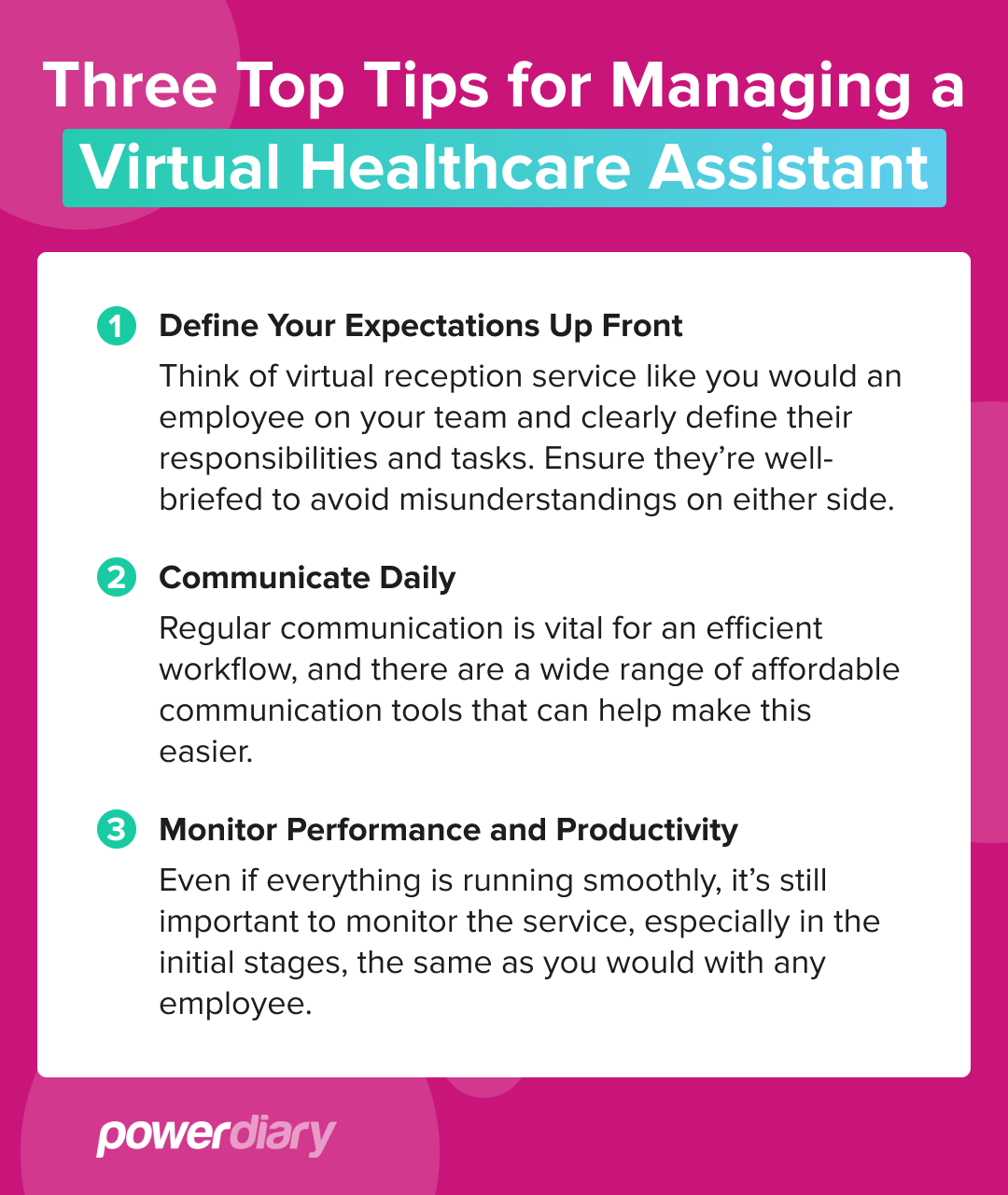How can I make every hour of my day more valuable? How can I reduce my involvement in the day-to-day grunt work and focus more on my clients?
If you find yourself pondering solutions to pain points like these in your practice, you might benefit from using a medical office virtual assistant.
Virtual reception and assistant services, while not a new concept, are becoming increasingly popular. These services allow healthcare professionals to free up precious time that can be used to provide quality care to patients – an appealing option for busy clinicians!
What is a Medical Office Virtual Assistant?
A medical office virtual assistant (VA) is a remote administrative professional who provides support services to healthcare providers. They can act as a virtual reception service or perform other administrative duties like scheduling appointments, updating medical records, and handling billing and insurance tasks.
“With the rise in virtual assistance companies, alongside the development of systems like Alexa and Google Assist, digital administration services have become the go-to for many small to medium medical businesses across the world,” says Kim Simmons, founder of Virtually Irreplaceable.
According to research, the global virtual administration and services market was valued at USD 2.48 billion in 2022, with an estimated annual growth rate of 24.3%. And, as an expert in the industry, Simmons notes that virtual solutions are here to stay.
“Virtual services run deeper than answering a few emails and calls here and there,” Simmons explains. “Private practice assistants can help you project-manage a wide range of energy-draining tasks, help you migrate your practice online, and lighten your team’s administration workload,” she adds.
While the level of assistance depends on various factors like workload and budget, here are a few pros and cons that may help with your decision to onboard a virtual reception service into your current practice.
Time-Saving
Pro:
One of the biggest advantages of virtual administration services is the time-saving factor. They can step in during particularly busy times of the year (think flu season!) when staff members are spread thin, keeping up with day-to-day tasks on top of their primary responsibilities.
“The main benefit of working with a virtual private practice assistant will be the time you will save working on your administration,” Simmons explains. “Outsourcing practice administration will enable you to focus on what you actually enjoy doing and what you’re good at.”
Con:
Since a virtual reception service team will not be physically in-office, you won’t always have a bird’s eye view of their work and be able to jump in to assist if needed. An issue that could take mere seconds to solve by simply popping your head around a door could snowball into a lengthy phone call or a thread of time-consuming, back-and-forth communication. However, you can get around issues like these relatively easily with good processes and policies in your Practice Operations Manual.
Cost Efficiency
Pro:
Setting up a virtual administration service can be more cost-effective than hiring a team of full-time, on-site support staff.
While salaries for these companies vary depending on experience and area of expertise, their hours are flexible, which means you can enlist their services when you, your team, and your clients really need them the most. And unlike full-time assistants who need to be paid a monthly salary (and added to your payroll), virtual reception companies can save you money by only working for a certain number of hours per week or during peak times of the day.
Con:
Hiring a virtual assistant is ideal if you’re just starting out in your private practice and can’t afford full-time help yet. However, a highly specialised medical office virtual assistant will charge premium rates, which means paying by the hour can be more expensive.
Additionally, you’ll need to invest in secure communication tools and practice management software, which adds another small monthly cost. But if you’re serious about your practice and your clients’ data, you’ll need a reputable system for bookings, treatment notes, and invoicing anyway.
Workflow and Organisation
Pro:
Highly trained digital administration companies in the health sector will not only help your business run like a well-oiled machine, they can also improve the way you conduct your daily operations.
“While hiring a virtual team of experts in practice admin can also offer you cost savings, they can also advise you on process and system improvements,” explains Simmons. “Utilising virtual platforms such as Power Diary is great, but working with a company who knows the ins and outs and how to best utilise the features can be a benefit to not only you but your clients as well.”
Virtual assistants are often experts at setting up templates, forms, and using the features of your software to really streamline operations. And, since using a virtual service doesn’t require a physical space in your office, it also allows for greater flexibility in setting up your workspace.
Con:
While the work of your virtual reception service can be completed according to your guidelines, you’ll need to release some control and come to terms with having outsiders (whom you may have never met) perform vital tasks for your business. Trust takes time, especially when we’re accustomed to thinking that if we want something done well, we have to do it ourselves.
Another factor to consider is that not all virtual assistant companies have expertise in the medical field or have intricate knowledge of specific admin processes. This means that certain tasks may be beyond their capability. And given the nature of remote working, you can’t always monitor the quality of their work or be on hand to suggest improvements, or solutions to issues that crop up unexpectedly.
This concern can be mitigated by doing your homework, interviewing different service providers, choosing a provider that specialises in private practices, putting in place good communication processes and, of course, taking a trial.
As Tayla from Virtually Equipped says, “Virtual reception and administration does not stop at reception – it finishes where you draw the line. If you engage the right assistant, align your business goals and the right personality for the culture of your practice, your business will flourish under the guidance of a virtual service, all for the right cost. By streamlining your practices you’re mitigating the risk for yourself, and your patients.”
Professionalism and Patient Experience
Pro:
One of the most notable advantages of setting up an efficient virtual reception service is that your patients will benefit. Medical visits are already daunting for many, but having a streamlined system can make all the difference between a good experience and a great one.
“Having someone on hand to respond to client enquiries, queries and appointment updates promptly will enable your practice to have a professional look from the start to the end of the client relationship,” explains Simmons.
As a side note, a virtual administration service enlisted to help with client-facing tasks is likely to be more focused because they’re working on the clock. Studies show that remote workers are typically between 35% to 40% more productive than in-office employees. In a remote setting, there are typically fewer distractions than in a traditional office environment.
Con:
Due to their lack of physical presence, virtual reception services can’t offer that in-person experience – a friendly face and calming presence to greet and welcome patients at your front desk.
An in-house receptionist also has the advantage of understanding your company culture. Being fully immersed in that physical environment means that they can instinctively know the right course of action in certain situations, especially when it comes to bottlenecks in the waiting room. With a virtual service, you can get around this with a careful onboarding process, much the same as you would employ with a new member of staff.
Three Top Tips for Managing a Virtual Healthcare Assistant:
Thinking about hiring an outsourced administration company to set up your virtual reception service? Here are three tips to help you ensure that they work productively within your healthcare practice:
1. Define Your Expectations Up Front
Think of virtual reception service like you would an employee on your team and clearly define their responsibilities and tasks. Ensure they’re well-briefed to avoid misunderstandings on either side.
2. Communicate Daily
Regular communication is vital for an efficient workflow, and there are a wide range of affordable communication tools that can help make this easier.
These include:
- Instant messaging on platforms like Slack, Microsoft Teams and WhatsApp
- Video calling software such as Zoom or Google Meet
A combination of these will usually work best.
3. Monitor Performance and Productivity
Even if everything is running smoothly, it’s still important to monitor the performance and productivity of your virtual assistant. This will help you identify any areas that need improvement and provide constructive feedback to your virtual assistant.
You could consider implementing a simple tracking system or setting up regular check-ins to discuss progress and address any concerns.
Types of Virtual Receptionist Solutions
Here’s a quick breakdown of the various solutions you might want to consider when setting up a virtual reception area:
Live Virtual Receptionists
This type of virtual assistance involves a live person answering calls and performing administrative tasks in real time, just as an onsite receptionist would. They’re usually available during regular office hours and can handle a wide range of tasks, such as scheduling appointments, managing emails and handling customer inquiries.
Automated Receptionist
An automated receptionist is typically used as a pre-recorded phone message, which greets callers with a pre-recorded menu option. It allows them to choose alternatives, such as being forwarded to someone to talk to or being able to verbally input their payment information or medical details.
Fully Automated Virtual Receptionists
These are solutions that can interpret the human voice while giving programmed responses. They work similarly to Alexa, Google Assist, Cortana, and Siri. This is not a widely used solution, but there is a good chance that as AI develops in the future, services like these may become more popular.
In Summary…
Hiring a medical office virtual assistant is a cost-effective and flexible option for many clinics. If you decide to hire a virtual receptionist, it helps to first look at where you and your staff need administrative support the most. A good way to do this is by tracking your tasks over a week. At the end of that time frame, you’ll have a much better idea of what you need to compare the different options available and make an informed decision.
You can then consider using a private practice virtual reception service to outsource the duties and responsibilities of admin roles using an approach similar to that of hiring a new staff member (but a lot easier).







